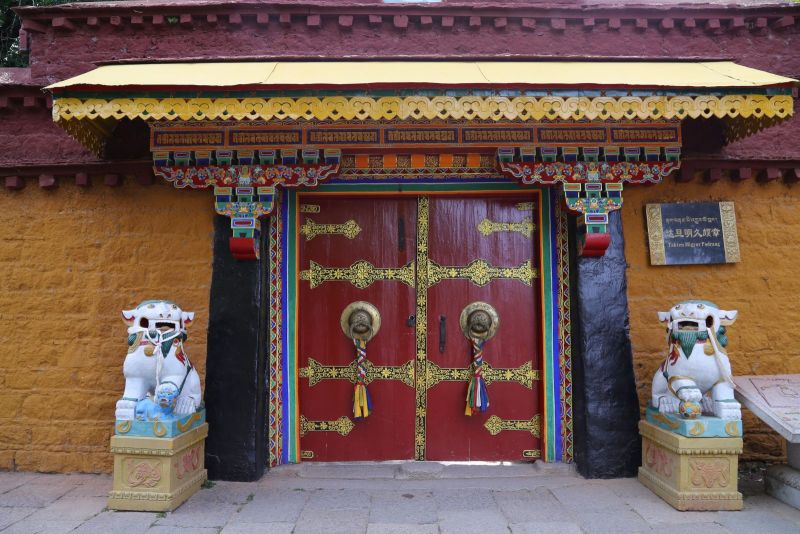Chinese Name: 罗布林卡 Pronunciation: luó bù lín kǎ
Building Time: 1755
Suggested Visiting Hours: 3 Hours
Best Visiting Time: All year round
Occupied Area: About 360,000 square meters
Address: No.21 Norbulingka Road, Chengguan District, Lhasa.
Building Function: Norbulingka was built for the Dalai Lamas spending summers and running governments.
| Tickets | Peak Season | Low Season |
| Admission Fee | 80 yuan | 60 yuan |
| Summer | Winter |
| 9:00-18:00 | 9:30-17:30 |
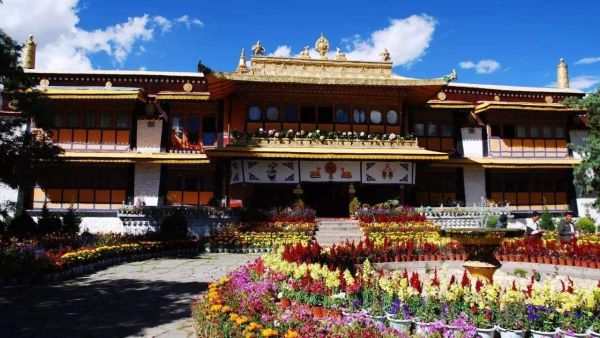
Norbulingka, meaning “ Treasure Park ”, is located in the western suburb of Lhasa City. It is a key national cultural relic site under state protection. Built in the 1740s (the 7th Dalai Lama), it is a typical Tibetan-style garden where successive Dalai Lamas spent their summers and ran their political affairs.
After more than 200 years of expansion, Norbulingka covers an area of 360,000 square meters with 374 rooms inside. There are more than 100 kinds of plants, including the common flowers and trees in the local area and the exotic flowers and rare herbs from the southern and northern foothills of the Himalayas and the rare flowers transplanted from the mainland or imported from abroad. Thus, it is also called “Highland Botanical Garden”.
Norbulingka is the largest man-made garden in Tibet with the largest number of scenic spots and historical sites. It is composed of several palace architectures, such as the Kalsang Potrang, Chensel Podrang, Takten Migyur Potrang and so on. Each palace architecture is divided into the palace section, the section in front of the places and the woods.
Known as a people's park, Norbulingka is jokingly described as "consisting of a water tower with two rows of craft shops and several palaces surrounding the zoo". It has gates on all sides, and the east is the main gate. It is divided into the eastern part, central part and western part. The eastern part includes the entrance and the front garden before the Weizhen Sanjie Pavilion. The central part includes the palace architecture. The western part is the Golden Card Lin characterized by natural jungle attractions.
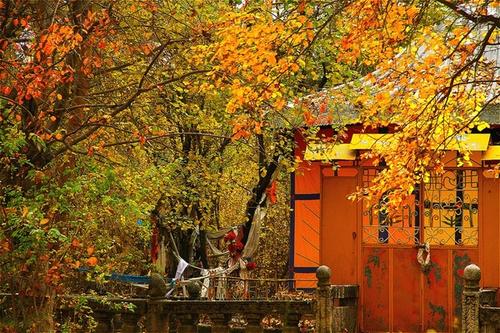
Before the 1740s, Norbulingka was a wasteland with wild animals, weeds and scrubs. The Lhasa River flows through this place. The Seventh Dalai Lama liked this place and often camped here for the summer. The Qing minister in Tibet built a pavilion for him. This was the earliest origin of Norbulingka.
In 1751, the Seventh Dalai Lama built the Kalsang Potrang in the east of the pavilion.
In 1755, with the approval of Yongzheng( the emperor in the Qing Dynasty), the Seventh Dalai Lama conducted government affairs in the Kalsang Potrang every summer. Kalsang Potrang was used as the Summer Palace for successive Lamas. On this basis, the eighth Dalai Lama expanded the Chabaekang (Reading Room), Khamsum Zilnon (Weizhen Sanjiege ) and Quran(Lecture Institute).
In 1922, the 13th Dalai Lama built the Chensel Phodrang Palace, Kalsang Dekyil Palace and Chime Chokyil on the west side of the Norbulingka, and built the Golden Card Lin in the southwest, and planted a large number of flowers and trees.
In 1954, the 14th Dalai lama built a new palace in the north of the Norbulingka and Takten Migyur Potrang in the central part of the Norbulingka, which brought the Norbulingka to its existing scales.
In April 2019, the Southwest Scenic Spots Alliance, which was jointly launched by eight units including Norbulingka in Tibet, set up in Wuhouci Museum in Chengdu.
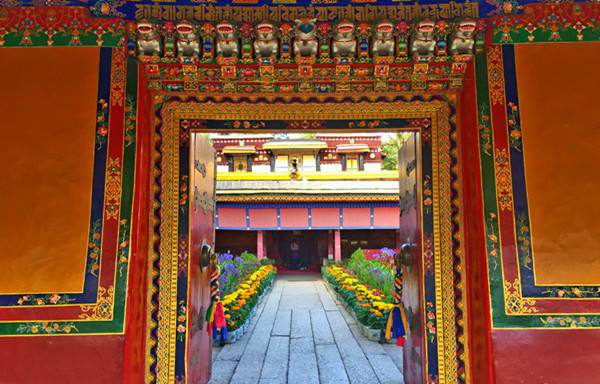
The complex buildings of Kalsang Potrang are located in the southeast of the south courtyard inside the second wall. Potrang means “palace” in Tibetan language.
Kalsang Potrang is one of the earliest palaces in the Norbulingka. Built in 1755, it was named after the seventh Dalai Lame-Kalsang Gyatso. It has been expanded by successive Dalai Lames to its present size. It consists of a protector deities hall, an assembly hall, a bedroom and a reading room. Consequently, it becomes the place for each Dalai Lame to deal with administrative affairs in summer.
When the 13th Dalai Lama was in power, he added the third floor. The first floor is the hall of scriptures. The second floor is Lakang (Arhat Hall), Gongkang (Guardian Hall ) and the Reading Room of Dalai, and the third floor is the place where Dalai Lamas met monks and secular officials.
On the second floor of the Kalsang Potrang, there are four frescoes, which are very eye-catching. It describes the scene of children playing. It is called “baby play”. From the clothing and hair styles of the children in the paintings, you can find a strong painting style of the Han nationality, which reflects the situation of China-tibetan cultural exchanges.
The main hall in the Kalsang Potrang , with the throne of the Seventh Dalai Lama, is full of precious Thangkas of Tara and statues of the Patron saints, with nearly 100 of them. The second floor enshrine and worship the Buddha of Sakyamuni, flanked by Sixteen Arhat.

The architectural complex of Chensel Phodrang Palace is located in the west of Norbulingka. The Chensel Phodrang Palace was first built in 1922 and then renovated in 1926 for the 13th Dalai Lame. It is one of the three great palaces of Norbulingka.
Chensel Phodrang Palace is also called Chensal Podrang. Chensal means “the Beloved” in Tibetan language. The presiding builder was a close confidant of the 13th Dalai Lama and he was called “Chensal Bela Work”. Therefore, when the palace was built, it was named after Chensal. This area has also been named as the Golden Card Lin.
There is a broad square with an area of more than 6,800 square meters in front of the Chensel Phodrang Palace. There is a passage paved with large stone slabs in the middle of the square. The passage is lined with trees such as pines, cypresses and poplars. The square is surrounded by a wall, forming a large courtyard. There are roses, peonies and other flowers in the courtyard , which forms an excellent scenery.
In the west corridor of the courtyard , there are two cars that were once used by the Dalai Lama. It is said that the two cars were separated and transported across the Himalayas.
The Chensel Phodrang Palace is a three-storey palace with halls for worshiping Buddhas. The ground floor is the Grand Sutra Hall, where the 13th Dalai met monks and laid officials and social personages. The second floor is the lounge for receiving personages, and the third floor is the place for holding a religious ceremony. Chensel Phodrang Palace has Worship Hall, Khenpo Room, Lecture Hall, Warehouse, and so on.
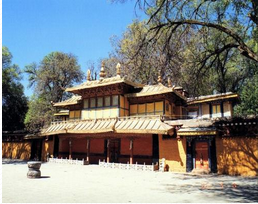
Designed for 14th Dalai Lame, the Takten Migyur Potrang was built in 1954 and completed in 1956. The new palace of the 14th Dalai Lama is called “ Takten Migyur Potrang”, which means “eternal palace” in Tibetan language.
The architecture has combined the characteristics of temples and villas. It is more magnificent than other palaces. This two-storey building is composed of more than 40 rooms, such as Buddhist Hall, Temple of Dharma Protection, Buddhist Practice Room, Sutras, Reception Room, Bedroom and Bathroom.
The Takten Migyur Potrang is commonly known as the New Palace. Although it is a modern building, the new palace is still in the traditional style on the outside, and it has a modern flavor in many facilities inside. For example, there is the bedroom of the 14th Dalai Lama on the west side of the hall, with his collapsed bed and two seats for his teachers. All the furnishings are in the ancient style, but you can also see the traces of modern times such as sofa and radio.
Entering the gates of the New Palace is like entering a sea of flowers. The New Palace has gold-plated roofs, which are mostly used in the main halls of Tibetan palaces and temples. It is called the golden roof. All these decorations symbolize the thoughts and teachings of Buddhism, such as Goldeer, Falun, and Spirit Beast.
The exquisite murals in the palace are well worth a mention and visit. For example, the picture of “Sakyamuni Talk” amazes the world. This mural was painted by the famous Tibetan painter, Master Anduo Qiangba, who was one of the most famous painters in Tibet in the 20th century.
This picture depicts the scene in which Sakyamuni, the Buddha, was giving a lecture in Luye Garden. The Buddha lied under an umbrella-shaped lime-tree, and his hands were inked. His clothes were smooth and elegant, with a graceful posture and a smile on his face.
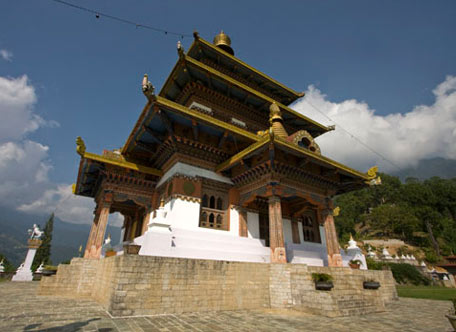
Khamsum Zilnon is a small wooden pavilion originally built in The Han style. The northeast of the Khamsum Zilnon is the Chabudian Lakang, which is a place for religious rituals. The north of the Khamsum Zilnon are kasha's offices and conference rooms. Every summer, many government offices in the Potala Palace are transferred to Khamsum Zilno with the Dalai Lamas.
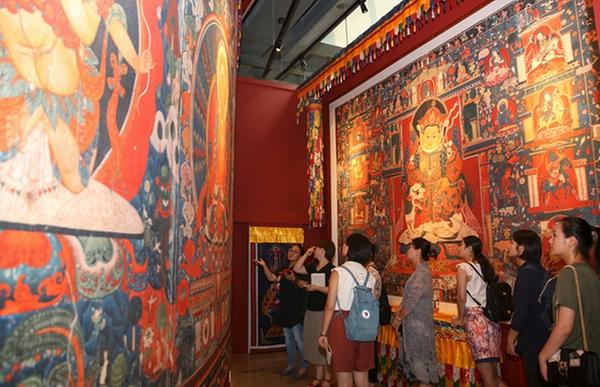
In the sea of Tibetan arts, Norbulingka is like a painting kingdom, whose painting style embodies the characteristics of the Miantang school in Tibetan painting arts. The Miantang School was founded in the 15th century by Myan Ratondup, who was born in Loza, Southern Tibet. This painting school, centered in Lhasa and popular mainly in central Tibet, is one of the three famous schools of painting in Tibet and the most influential school of painting in modern Tibet.
As for the Miantang School, we can find that the painting style is rigorous and exquisite. The painter pay attention to the description of scenery. The lines are neat and smooth. Tonal change is rich and lively bright. The subject matter is rich and varied. Many of palaces in Norbulingka epitomized the best of the school from the 18th century to the 20th century, especially the Takten Migyur Potrang.
The group of murals in the Takten Migyur Potrang was painted in 1956 by more than 30 painters. The murals contain major events in Tibet from ancient times to the present in the form of a comic strip, consisting of 301 paragraphs of text and 246 frames, which reflects the wonderful legend of Tibetan origin, the rise and fall of various dynasties in Tibet, and so on.
This murals are based on the ancient Tibetan historical paintings and extended to the modern history. The murals are painted on the west, northwest, northeast and east walls of the Temple of “Si Xi Dui Gu”. They are arranged from left to right, top to down. The west wall to the northwest wall depict the content of the pre-Hongqi period of Tibetan Buddhism, and the northeast wall reflects the content of the post-Hongqi period of Tibetan Buddhism, and the east wall focuses on the biographies of the Dalai Lamas of all generations.
Based on the theory of Miantang School, this mural focuses on the painting from three aspects. First of all, the characterization is exquisite, focusing on the aspects of image expression and posture, vividly showing the character's inner changes.
Secondly, it uses realistic techniques to draw regional palaces, houses, costumes and festival ritual scenes.
Finally, it combined traditional painting and inland landscape painting techniques, which places the picture in the realm of beauty. The value of mural painting is far more than the mural art itself. What it describes and records is as constant as the meaning implied in the Takten Migyur Potrang.
Take bus No.14 or No.24 to Norbulingka.
Take bus No.2 to the south entrance of Norbulingka.
